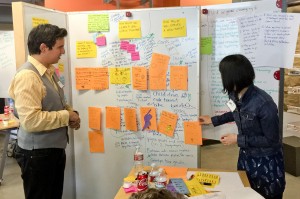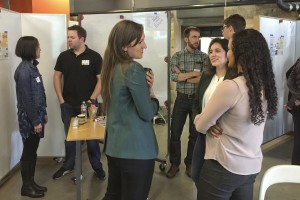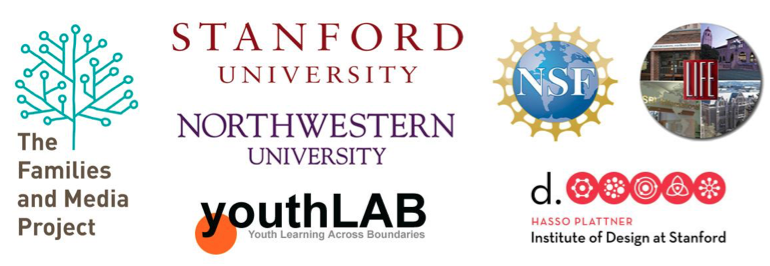A Collaborative Experiment
On January 23, 2015, researchers, educators, and digital media professionals spent the day at Stanford’s Hasso Plattner Institute of Design (aka the d.school) to imagine how to better support the needs and interest-driven learning of families with children through digital media. The “Designing Media for Underserved Families” event, funded by the National Science Foundation’s Cyberlearning and Future Learning Technologies program, continued in the cross-sector collaborative spirit of the LIFE Center and the Families and Media consortium, in which researchers from Stanford University, Northwestern University, the Joan Ganz Cooney Center, Rutgers University, and Arizona State University conducted ethnographic research to more deeply understand the ways in which children and families learn together with and around digital media and technology.

The design workshop brought together a blend of experts from universities, think-tanks, children’s media production companies, and child advocacy organizations, including among many others, representatives from Common Sense Media, Sesame Workshop, WGBH, KQED, PBS KIDS Digital, Google, SRI International, Launchpad Toys, Motion Math, Kidaptive, and the Center for Children and Technology at EDC.
This event was the second of two workshops arranged in order to cultivate future interdisciplinary work among researchers, educators, designers, and industry professionals who all wish to utilize the potential of digital media to contribute to children’s learning. While the first workshop, hosted by co-PIs Reed Stevens and Ellen Wartella, focused on research methods, the second workshop, hosted by co-PIs Brigid Barron and Roy Pea, focused on design. Barron framed the day as an experiment to see whether and how deep, case-based ethnographic research could be used in a rapid design process to both generate fresh design ideas and catalyze new collaborations among researchers, educators, and designers.
Ethnographic Research + Design Thinking
Event organizers Dr. Brigid Barron (Associate Professor, Stanford GSE), Dr. Amber Levinson (postdoctoral scholar, Stanford GSE), and Dr. Susie Wise (Director, K12 Lab Network) divided approximately fifty workshop participants into seven teams to eventually work on a set of design challenges prompted by case studies of young Hispanic-Latino children and their families. In addition, because each group had varying experiences with design thinking, each team had a design thinking coach to guide them through the process (several coaches were former or current Stanford graduate students). Design groups warmed up their collaborative thinking with “Yes, but” versus “Yes, and” conversations, and were encouraged by their coaches to build upon each other’s ideas and to refrain from judgment in order to optimize the creative process. Then, they were introduced to the steps of the design thinking process that they would follow for the day: (1) Empathize (with the family), (2) Define (the issues), (3) Ideate (idea generation), (4) Prototype, and (5) Test.
The case studies used for the Empathy stage were drawn from cases from Amber Levinson’s dissertation, TAPPING IN: Understanding How Hispanic-Latino Immigrant Families Engage and Learn with Broadcast and Digital Media (Levinson, 2014). Though Levinson’s mixed-methods research with mostly Spanish-speaking, low-income families in the San Francisco Bay Area included six months of ethnography, workshop organizers needed to find a way to present rich representations of the families for the purposes of a one-day event. In addition to thoughtfully representing each family, they also wanted to be mindful of demonstrating the diversity within the Hispanic-Latino community. To do this, they presented descriptive video clips of three of Levinson’s seven families, and also created laminated ethnographic research “case-mats” for each group that included in-depth information on each family’s daily life, immigration story, interests, strengths, stressors, and values. The “case-mat” design was originally developed for educator workshops by PI Barron and a member of her YouthLab team, Caitlin Kennedy Martin, and based on ethnographic cases focused on interest-driven learning.
Each group was tasked to design for a single individual within an assigned family. For example, one team was assigned to a mother in a family who recently immigrated from Yucatán, Mexico, speaks primarily Spanish, and takes her son to the library to read e-books in order to improve his English skills. Another team designed for her son, who greatly enjoys comic books and drawings, but the books that align with his interests unfortunately do not have content at his reading level. Using the video clips and “case-mats” as guides, group members discussed their potential product user’s lifestyle, hobbies, and possible needs to be addressed. After thoroughly familiarizing themselves with the family’s interests, needs, and circumstances, workshop participants worked together through each of the remaining design steps in a flurry of post-it notes and marker-covered whiteboards. Finally, groups shared out their design solutions to participants in other groups.
Reflections

After a long day of design thinking and teamwork, workshop participants had the chance to debrief with the event organizers about what they had learned, aspects of the day that they enjoyed, and next steps for designing the next iteration of this experiment. In general, there was great enthusiasm for the use of the ethnographic case research for design. Participants enjoyed seeing the clips and “case-mats” which provided a window into each family’s life, and allowed the groups to attempt to meaningfully address different topics including language-learning, interest-driven learning, asynchronous and distance learning, and community-based learning.
Workshop attendees also raised several questions and points to consider: A primary consideration was the nature of longitudinal ethnographic research, which can be very time consuming and expensive and, may not directly align with the design process, which requires very rapid thinking and iterations. How can the next iteration of this workshop push the research-design partnership even further? How can ethnographic researchers choose the most important aspects of their large bodies of work to present to designers? In addition, how do the varying experiences of researchers and designers play into group dynamics when designing together? Exemplifying a common challenge in interdisciplinary collaborations, some researchers noted that they held back some of their contextual knowledge for the sake of the rapid process, while some designers held back their creative expertise for the sake of the those very new to design-thinking. Several participants noted that it would be ideal to have more than one meeting to best capitalize on the distributed expertise of the workshop participants. The organizers also reflected on a need for ways to rapidly summarize basic research on learning in forms that design teams can productively utilize.
Finally, workshop attendees were excited to think about future ways in which this process could be refined and improved for even more impactful results. Suggestions included workshops in which designers help researchers design products based on their research findings, as well as workshops in which researchers advise developers on redesigning existing products to make them more culturally relevant and usable to a wider range of families.
For more information on the design thinking process used at the workshop, click here.


